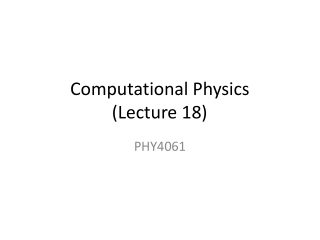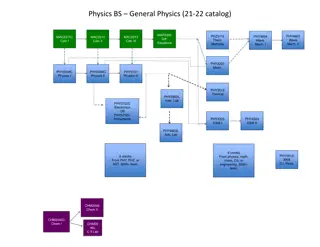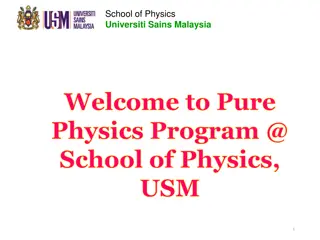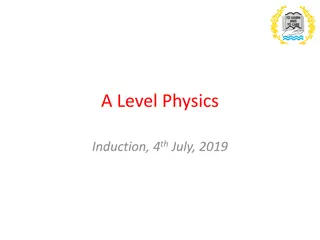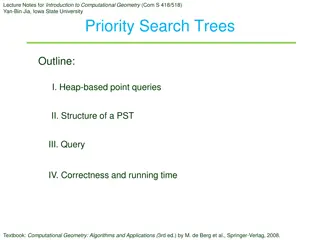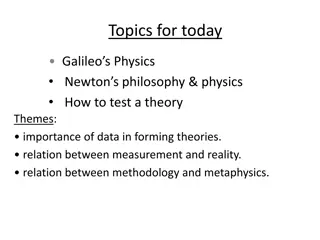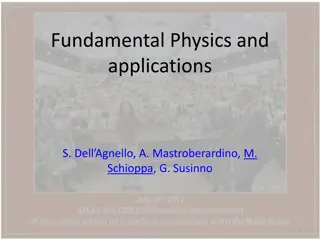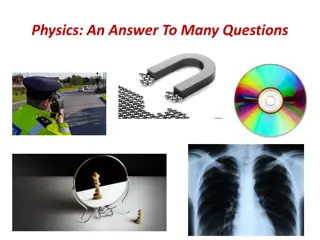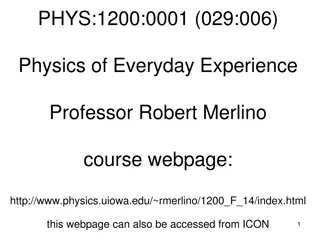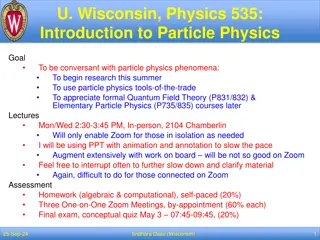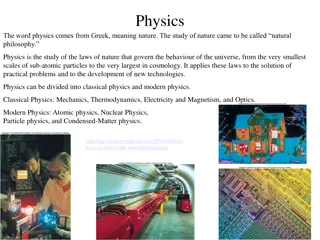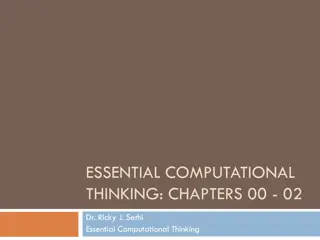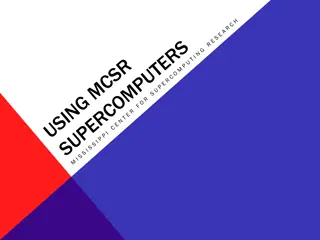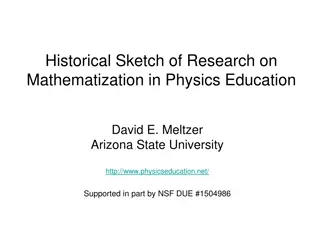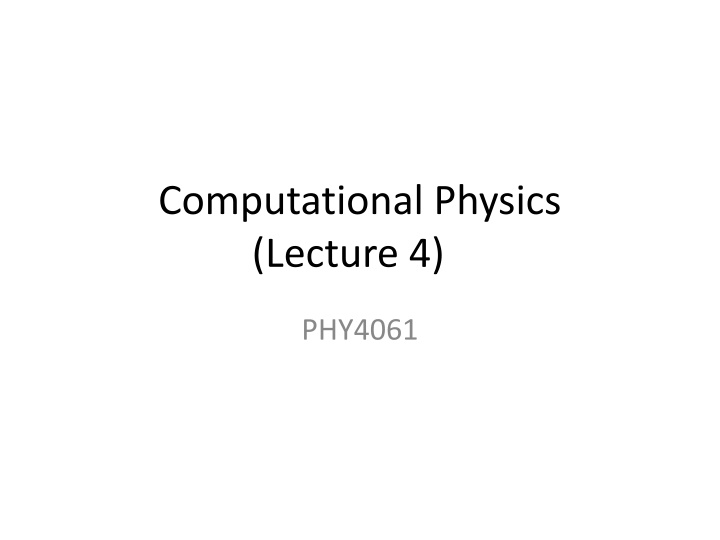
Computational Physics Lecture 4: Formulas, Random Variables, Importance Sampling
Learn about five-point and three-point formulas for derivatives, random variables, density functions, distribution functions, and importance sampling in computational physics. Understand algorithms and code for importance sampling using Metropolis algorithm.
Download Presentation

Please find below an Image/Link to download the presentation.
The content on the website is provided AS IS for your information and personal use only. It may not be sold, licensed, or shared on other websites without obtaining consent from the author. If you encounter any issues during the download, it is possible that the publisher has removed the file from their server.
You are allowed to download the files provided on this website for personal or commercial use, subject to the condition that they are used lawfully. All files are the property of their respective owners.
The content on the website is provided AS IS for your information and personal use only. It may not be sold, licensed, or shared on other websites without obtaining consent from the author.
E N D
Presentation Transcript
Computational Physics (Lecture 4) PHY4061
A five point formula: Obtained by a combination of 4 Taylor series with cutoffs at third order. f(x+h) = f(x) + hf`(x) + h2f``(x)/2+h3f (x)/6 f(x-h) = f(x) - hf`(x) + h2f``(x)/2-h3f (x)/6 f(x+h) f(x-h) = 2hf`(x) +h3f (x)/3 Similarly, we have: f(x+2h) f(x-2h) = 4hf`(x) +8h3f (x)/3 We can cancle the third order term to obtain the formular. For a second-order derivative. A three point formula is given by the combination: (Derivation is simple, you can work it out by yourself)
Random Variable, density function and distribution function Random Variable: Value is not predetermined, but the value distribution is known. (Probability of each value is known. ?? ? ?? f(x) is the probability distribution density function. Probability distribution function F(x)= ? ? f(x)=dF(x)/dx P(a x b)= ? ?
Calculate it intelligently: Importance sampling: Take some probability distribution function P(x). (normalized). The integration is now: If we take, is zero!! Of course, we don t know I . However, we know the shape of f(x). Therefore, we still can construct a P(x), to reduce the error.
Consider this algorithm: construct a series of random numbers: 1, Randomly pick: a random number in : adjustable parameter. evaluate 2, Suppose, for each ; If let If generate another random number: If let Otherwise,
Code for Importance sampling(Metropolis algorithm) f (x) = x2. Distribution function as W(x) = 1 positive definite. The normalization constant Z is given by ? (??2-1) calculated from another numerical scheme for convenience. The corresponding function g(x) = f (x)/W(x) is given by g(x) = Z x2/(??2-1).
// An example of Monte Carlo simulation with the // Metropolis scheme with integrand f(x) = x*x. import java.lang.*; import java.util.Random; public class Carlo { static final int nsize = 10000; static final int nskip = 15; static final int ntotal = nsize*nskip; static final int neq = 10000; static int iaccept = 0; static double x, w, h = 0.4, z = 0.46265167; static Random r = new Random(); public static void main(String argv[]) { x = r.nextDouble(); w = weight(); for (int i=0; i<neq; ++i) metropolis(); double s0 = 0; double ds = 0; iaccept = 0; for (int i=0; i<ntotal; ++i) { metropolis(); if (i%nskip == 0) { double f = g(x); s0 += f; ds += f*f; } } s0 /= nsize; ds /= nsize; ds = Math.sqrt(Math.abs(ds-s0*s0)/nsize); s0 *= z; ds *= z; double accept = 100.0*iaccept/(ntotal); System.out.println("S = " + s0 + " +- " + ds); System.out.println("Accept rate = " + accept + "%"); }
public static void metropolis() { double xold = x; x = x + 2*h*(r.nextDouble()-0.5); if ((x<0) || (x>1)) x = xold; else { double wnew = weight(); if (wnew > w*r.nextDouble()) { w = wnew; ++iaccept; } else x = xold; } } public static double weight() { return Math.exp(x*x) - 1; } public static double g(double y) { return y*y/(Math.exp(y*y)-1); } }
The step size is adjustable keep it such that the accepting rate of the new configurations is less than or around 50% such a choice of accepting rate is compatible with considerations of speed and accuracy. we can easily modify it to study other problems. In practice how do we decide the step size when we run the code?
Performance of the random sampling method Bad, really bad, error is proportional to N-1/2 Trapezoid rule, error is proportional to N-2 Advantage in multi-dimensional integrals! Suppose we have a many body system, for example 10 particles, then we have 30 dimensions! For random sampling method, error is just proportional to N-1/2 For trapezoid rule, it is proportional to N-2/d! Suppose we have 1023 particles!
Roots of an equation Find the possible value of x that ensures the equation f (x) = 0 If such a value exists, we call it a root or zero of the equation. Discuss only single-variable problems The discussion of multivariable cases will be discussed later in matrix operations.
Bisection method If we know that there is one root x = xr in the region [a, b] for f (x) = 0, the bisection method to find it within a required accuracy. Very intuitive and simple method. Because there is a root in the region, f (a) f (b) < 0. divide the region into two equal parts with x0 = (a + b)/2. Then we have either f (a) f (x0) < 0 or f (x0) f (b) < 0. If f (a) f (x0) < 0, the next trial value is x1 = (a + x0)/2; otherwise, x1 = (x0 + b)/2. This procedure is repeated until the improvement on xkor | f (xk)| is less than the given tolerance .
One example f (x) = exln x x2 when x = 1, f (x) = 1 when x = 2, f (x) = e2ln 2 4 1. At least one value xr [1, 2] that would make f (xr) = 0. In the neighborhood of xr, we have f (xr + ) > 0 and f (xr ) < 0.
Sample code // An example of searching for a root via the bisection // method for f(x)=exp(x)*ln(x)-x*x=0. import java.lang.*; public class Bisect { public static void main(String argv[]) { double x = 0, del = 1e-6, a = 1, b = 2; double dx = b-a; int k = 0; while (Math.abs(dx) > del) { x = (a+b)/2; if ((f(a)*f(x)) < 0) { b = x; dx = b-a; } else { a = x; dx = b-a; } k++; } System.out.println("Iteration number: " + k); System.out.println("Root obtained: " + x); System.out.println("Estimated error: " + dx); } // Method to provide function f(x)=exp(x)*log(x)-x*x. public static double f(double x) { return Math.exp(x)*Math.log(x)-x*x; } }
The Newton method Based on linear approximation of a smooth function around its root. Taylor expansion near the root xr : f (xr) f (x) + (xr x) f (x)+ = 0 x: a trial value for the root of xr at the kth step and the approximate value of the next step xk+1 can be derived from f (xk+1) = f (xk) + (xk+1 xk) f (xk) 0 Therefore, xk+1 = xk+ xk= xk fk/ fk k = 0, 1, . . . . Here fk= f (xk). The above iterative scheme is known as the Newton method or Newton Raphson method.
The above equation is equivalent to approximating the root by drawing a tangent to the curve at the point xkand taking xk+1 as the tangent s intercept on the x axis.
// An example of searching for a root via the Newton method // for f(x)=exp(x)*ln(x)-x*x=0. import java.lang.*; public class Newton { public static void main(String argv[]) { double del = 1e-6, a = 1, b = 2; double dx = b-a, x=(a+b)/2; int k = 0; while (Math.abs(dx) > del) { dx = f(x)/d(x); x -= dx; k++; } System.out.println("Iteration number: " + k); System.out.println("Root obtained: " + x); System.out.println("Estimated error: " + dx); } public static double f(double x) {...} // Method to provide the derivative f'(x). public static double d(double x) { return Math.exp(x)*(Math.log(x)+1/x)-2*x; } }
Discussions The root = 1.694 600 92 after only five iterations! more efficient The error is much smaller even though we have started the search at the same point a much smaller number of steps. Each newstep size in the Newton method is determined by the ratio of the value and the slope of the function f (x) at xk. For the same function value, a large step is created for the small- slope case a small step is made for the large-slope case. This ensures an efficient update and Important to understand this algorithm to finish PROJ A. Problem: We may not know the form of the derivative
Secant method Very simple improvement. Just replace F with a two point formula for the first order derivative. xk+1 = xk (xk xk 1) fk/( fk fk-1). Known as secant method or discrete Newton method. Disadvantage: Need two points to start. Advantage: Don t need to have the knowledge of the first derivative!
// An example of searching for a root via the secant method // for f(x)=exp(x)*ln(x)-x*x=0. import java.lang.*; public class Root { public static void main(String argv[]) { double del = 1e-6, a = 1, b = 2; double dx = (b-a)/10, x = (a+b)/2; int n = 6; x = secant(n, del, x, dx); System.out.println("Root obtained: " + x); } // Method to carry out the secant search. public static double secant(int n, double del, double x, double dx) { int k = 0; double x1 = x+dx; while ((Math.abs(dx)>del) && (k<n)) { double d = f(x1)-f(x); double x2 = x1-f(x1)*(x1-x)/d; x = x1; x1 = x2; dx = x1-x; k++; } if (k==n) System.out.println("Convergence not" + " found after " + n + " iterations"); return x1; } public static double f(double x) {...} }
Reciprocal lattice and programming on reciprocal lattice
How to program a reciprocal lattice b1=2 (a2 x a3) / = a1 (a2 a3) volume of the unit cell b2=2 (a3 x a1) / b3=2 (a1 x a2) / So here, suppose we know a1, a2 and a3 vectors in the real space. (for each ai, we just store the Cartesian coordinates in an array, a1(), a2() and a3(). All we need to calculate is the volume of the unit cell and the cross product of two unit vectors. These two tasks are very easy and straight forward.
Periodic boundary condition In simulations, we can only calculate a relatively small unit-cell (super cell) comparing with the infinite lattice. We can apply periodic boundary condition to simulate the infinite lattice. More or less like a video game. How to calculate the distance of two points in a unit cell applied with a periodic boundary condition?
Fractional coordinates In crystallography, a fractional coordinate system is a coordinate system in which the edges of the unit cell are used as the basic vectors to describe the positions of atomic nuclei. Suppose we have an atom at t(x1, y1, z1). The basis vectors for the unit cell is a1, a2 and a3 and the basis vectors for the reciprocal cell is b1, b2 and b3.
t = n1a1+n2a2+n3a3 (n1, n2 and n3 are fractional numbers) t b1=n1a1 b1=2n1 , t b2=n2a2 b2=2n2 t b3=n3a3 b3=2n3 Therefore, ni=t bi (i=1,2,3) (in unit of 2 ) Then we take mod (ni, ,1.0) (the number is now from 0 to 1.0) Not only atomic position, we can also use fractional coordinates to describe inter-atomic distance.
a2 a1
PBC for distance of atoms Suppose (x1, y1, z1) is the distance of two atoms. We can also apply PBC to help us to check the neighbor list in the future. From the fractional coordinates, simply shift the allowed range to (-0.5, 0.5) and return n1, n2, n3 and (x2,y2,z2) in Cartesian coordinates. How do we shift? These (x2,y2,z2) are the minimum distance of two atoms with PBC applied.
Neighbor lists After the set up of a unitcell, We can just keep the list of neighbor atoms. The key is to calculate the distance of atoms with the periodic boundary condition applied. x1=rv(1,i)-rv(1,j) y1=rv(2,i)-rv(2,j) z1=rv(3,i)-rv(3,j) call pbc(x1,y1,z1,x2,y2,z2) dist=x2*x2+y2*y2+z2*z2 Then we compare the dist with rc. If the dist < rc, we store the coordinates in an array of the neighbor list of ith atom.
3, Show the packing fraction in the following crystal structures: bcc = ( 3/8)pi, fcc = ( 2/6)pi, and Diamond=( 3/16)pi. 4, write a small program to integrate f(x) = x8 from [-1, +1] using trapezoidal rule and random sampling. Calculate the squared deviation from the true value as a function of M sample points or N slices and compare the difference of these two algorithms, as shown in the lecture notes. Submit your HW solution, code, and a brief report of problem 4 to our TA. Due in two weeks.
Project A Part II 1 calculate a reciprocal lattice vectors b1, b2 and b3 from the lattice vectors of a1, a2 and a3 (unit cell) in real space, calculate and return the volume of the unit cell. Store the x, y, z coordinates of ai and bi in arrays. Test SC, BCC, FCC to make sure the code is correct. Note that the reciprocal lattice vectors for primitive cell of BCC is FCC and vice versa. 2 input a coordinate (x1, y1, z1) with (a1,a2,a3) as the unit cell, apply periodic boundary conditions, return the fractional coordinates n1, n2, n3 (in the range of (-0.5, 0.5) and the (x2, y2, z2) Hint, call the code of reciprocal to have (b1,b2,b3) ready, then take the dot product and mod.
3 Neighbor list Input a1, a2 and a3 vectors, atomic positions in the unit cell, distance cutoff. Calculate the neighbor list of each atom, the distance from the neighbor to each atoms. Hint, use reciprocal and pbc code to store all the information into neighbor list arrays and distance arrays. Check the case of simple cubic, FCC and BCC. Hint: make sure the cutoff is correct for nearest neighbors. Due in two weeks after the lab of part II.

